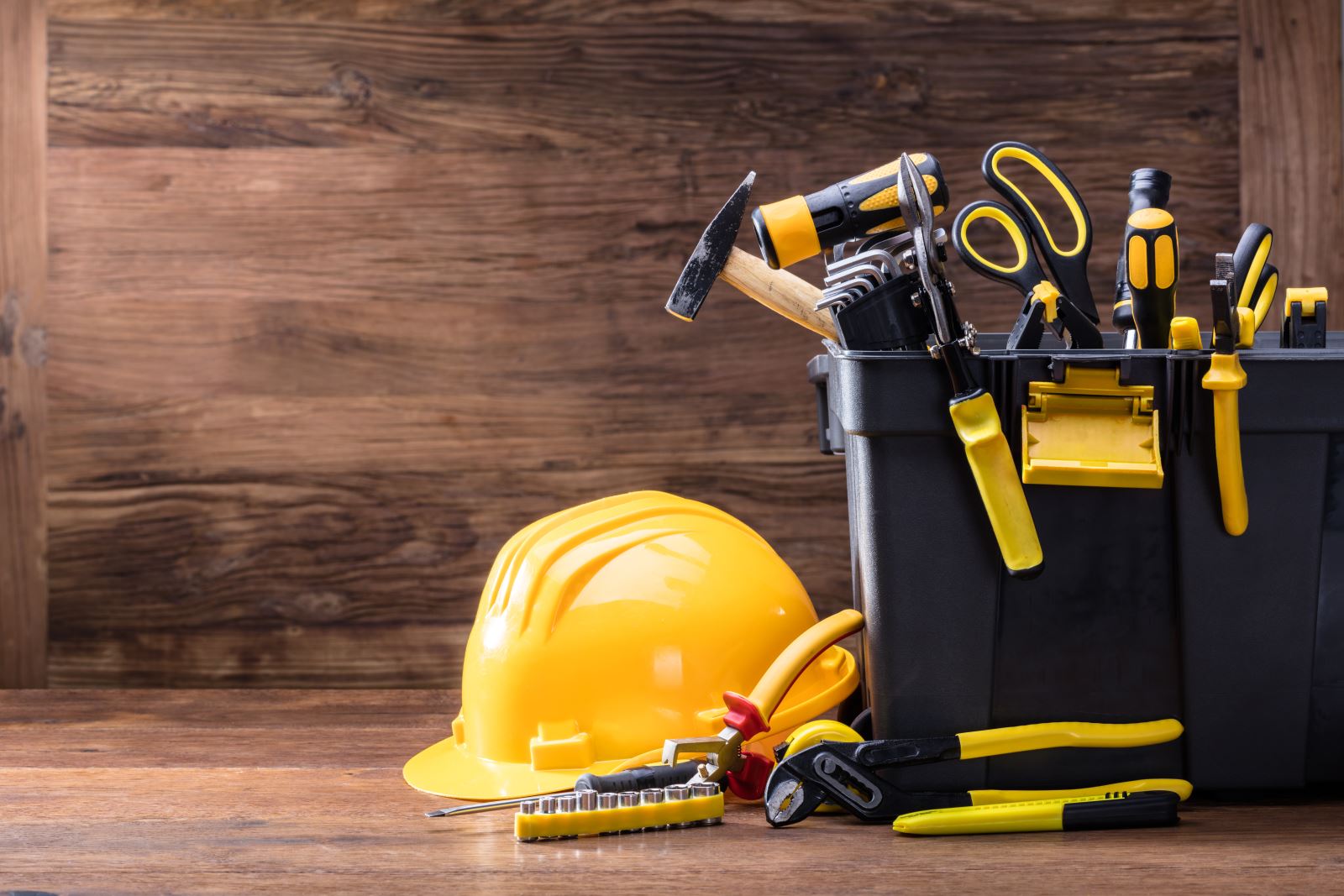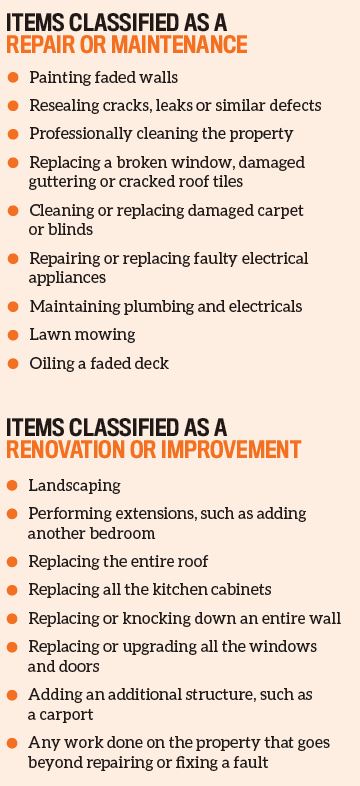
OWNING A quality investment property can be compared to sitting on well-rained-on soil. And much like the temperament of the weather, how the rental market performs and whether you will turn a profit are also subject to bouts of uncertainty. Fortunately, what you do when managing your investment can help ensure you pocket more profits at the end of the day, regardless of whether the market rains demand or not.
Now that the home renovation culture has swept living rooms nationwide, the fear of becoming involved with an eyesore fixer-upper has evolved into a pastime. More than ever, the idea of buying and renovating, of tearing down and building, of stripping and painting, is on the agenda. Investors are increasingly approaching upgrades as hands-on projects, relying on DIY confidence and a cost-savvy vigour as their main angles of attack.
But no matter how much, or how little, your reno budget holds, a few questions remain. Which repair costs can be funnelled back to you through a well-prepared tax claim? And which costs can be allocated to renovation and therefore added to your cost base – only making their benefit known once you sell the property?
The rule of wear and tear
The Australian Taxation Office stipulates that a rental owner is entitled to claim the costs of any type of work done to an investment property, provided that the expense ultimately contributes towards its overall maintenance and repair.
With the term ‘repair’, the ATO is referring to any corrections that are made to repair damages, defects or instances of wear and tear affecting the property during the time it is rented out to tenants.
“To repair something means to fix defects, including renewing parts. It does not include total reconstruction,” the ATO confirms.
In other words, while the replacement of a broken shower head or the resealing of a leaking bathtub are both considered claimable at tax time, transforming a perfectly functioning bathroom into an art deco meets Moroccan affair most likely wouldn’t receive the tax office’s seal of approval.
At the other end of the spectrum, there are the costs that are put towards maintenance of the rental property, which are also tax deductible. But what type of work does this cover?
Ultimately, maintenance claims can include any type of work done to the property that prevents it (or a part of it) from deteriorating or eventually becoming broken or unusable.
The ATO recognises things like painting, oiling, brushing, cleaning, and the upkeep of electricals and plumbing as being tax claimable. For example, equipment or tools that are purchased to buff away rust, mould or ingrained dirt can be deducted, as can hiring an electrician or a plumber to mend a faulty cable or pipe. Other examples include replacing a broken window, cleaning out a blocked fan unit and hiring a professional to make a soiled carpet spotless again.
It’s important to note that all maintenance and repairs done to the property must be claimed within the year they are performed, and any deterioration or wear and tear needs to have occurred at the property during the period in which it was rented out. It’s advisable to be well prepared and organised, including filing and making electronic copies of each receipt and invoice to support each claim.
Improvement or repair?
What if you’re contemplating that art deco meets Moroccan bathroom reno?
No doubt, remodelling a space is a sure-fire way to attract a rental crowd and increase its value to potential tenants – and it can be especially rewarding if you one day decide to put the home on the market for sale.
But since such work is recognised by the ATO as an ‘improvement’, renovations of this nature and scale won’t be immediately claimable in your yearly tax lodgement.
According to the ATO, an improvement is classified as work that “provides something new, generally furthers the income-producing ability or expected life of the property, generally changes the character of the item you have improved, and goes beyond just restoring the efficient functioning of the property”.

So, how can you predict whether you’re about to cross that line?
Understanding what separates repair or maintenance work from an improvement requires asking yourself the right questions prior to starting
Intention, design and materials
Understanding what separates repair or maintenance work from an improvement requires asking yourself the right questions prior to starting. Am I fixing or enhancing this? How will what’s about to be done change what was already there?
Those are simply the initial questions. Being able to take a step back from the situation and assess how you’re going to execute the job, and what materials you’re going to use, is just as crucial. Because while you might want to carry out maintenance work with the peace of mind that it will be claimable on your tax return, you don’t want to give something a new-angled character, functionality or purpose.
Filling in the cracks in a wall and giving it a fresh coat of paint is very different to rendering the wall for the first time. Knocking the wall down to create an open design plan will also substantially change the look or character of a property, rather than only remedy the faults it might have, so the costs of such a job will largely not be accepted as a tax claim by the ATO.
Generally, when approaching a repair or any maintenance work, you want to look at what the damaged or deteriorated structure is already made of and use similar – if not the same – materials.
Builders, painters, electricians and other professionals can provide an itemised invoice upon request, which will break down each part of the work they have executed, allowing you to separate the costs of the improvements from the costs of the repairs and maintenance work when lodging your claim.
Not all is lost
Let’s say you’ve gone full steam ahead and just wiped the final dust from your upscale bathroom renovation. But you’re a little deflated, knowing that you’re unable to receive an immediate tax deduction on the impressive upgrade you’ve funded.
Fortunately, there’s still an opportunity to gain a return on the costs of an improvement, although you won’t be able to do this off the bat with a tax return, but instead by claiming a capital works deduction.
The ATO specifies what capital works expenses can be claimed, which include “building construction costs, the cost of altering a building and the cost of capital improvements to the surrounding property”.
Whether you’ve transformed a fixer-upper into a sparkling new rental immediately after settling the purchase; ripped out all the eroded kitchen cupboards to make space for new ones; entirely replaced a fence or added an extension to a property, these may all be claimable as capital works deductions – but you must claim them over a number of years, and you can only do so if the work meets certain conditions.
Structural improvements are also deductible through this means, as well as any costs associated with hiring an architect, engineer or surveyor, and any fees related to building permits and excavations.
However, the property has to have been erected after 17 July 1985 to be eligible for capital works deductions, and what you get back in your pocket will be shaped by the nature of the construction work and the date you began it.
While it’s advantageous to conduct independent research on what costs can be claimed from work done on investment properties, it’s also advisable to meet with a qualified accountant or tax agent to get their advice on your particular situation. Considering the range of works that can be conducted on a property, the varying scenarios from investor to investor, and the need to adhere to tax law and certain conditions, a professional is best placed to ensure that your claim is both strong and accurate.
